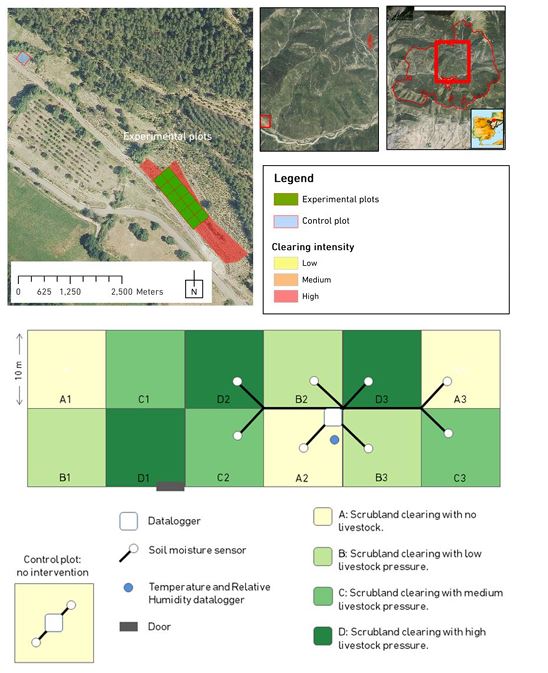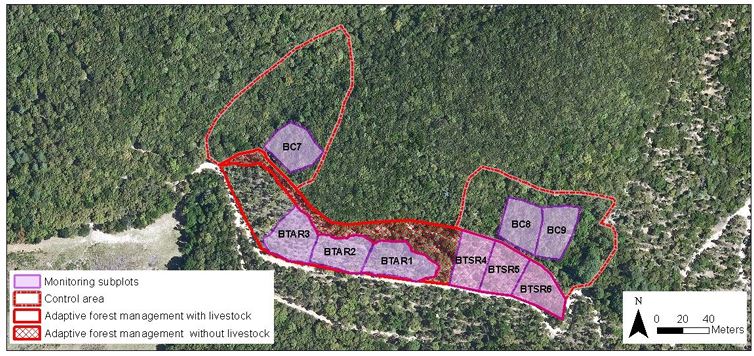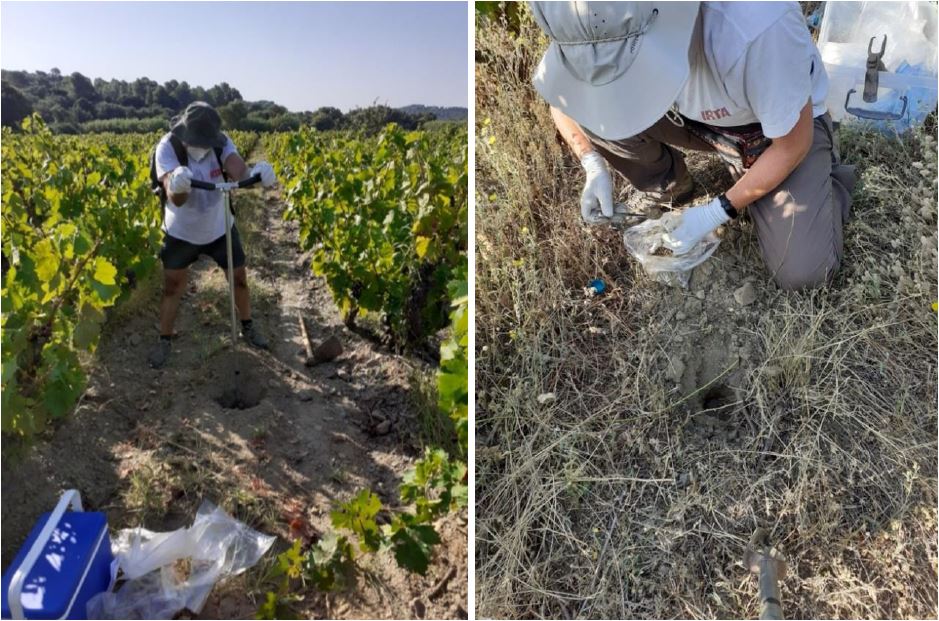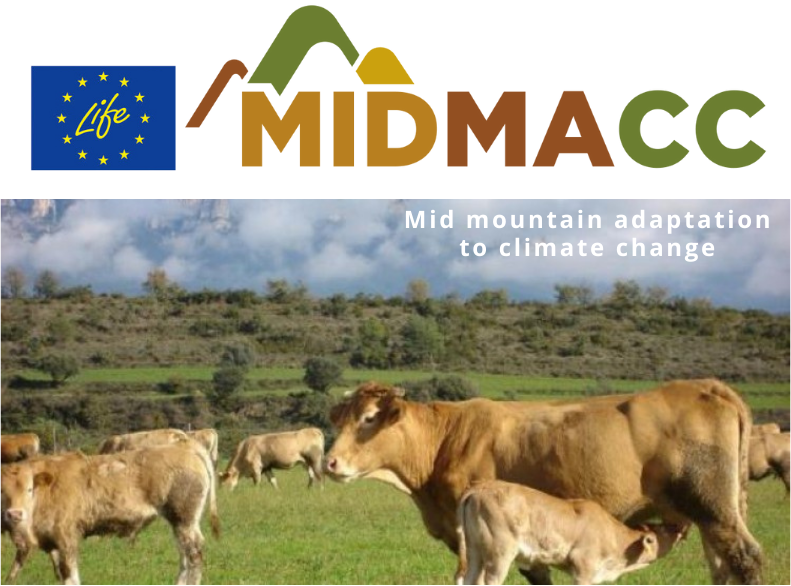The results of the LIFE MIDMACC Mid-mountain adaptation to climate change project on adaptation to climate change in mid-mountain areas demonstrate the importance of wooded areas in pastures for adaptation to climate change.
The results of the LIFE MIDMACC Mid-mountain adaptation to climate change project on adaptation to climate change in mid-mountain areas demonstrate the importance of wooded areas in pastures for adaptation to climate change.
Mountain areas in southern Europe are highly sensitive to climate change. In Mediterranean mid-mountain areas, available water resources have progressively decreased in recent decades due to climate change. In particular, longer and more severe droughts, coupled with more frequent and more intense heat waves, are increasing the vulnerability of these areas to forest fires and to the forest decline phenomenon . In addition, the progressive abandonment of traditional land uses due to the lack of generational replacement is causing a generalised loss of mosaic landscapes, which are more resilient to climatic extremes. In this context, the LIFE MIDMACC project, Mid-mountain adaptation to climate change, has implemented concrete adaptation strategies in 3 strategic areas in the south of the Pyrenees, north of the Iberian Peninsula, through innovative landscape management techniques.
The project has implemented different adaptation strategies in the pre-Pyrenean territory of the provinces of La Rioja, Aragon and Catalonia.
Main findings of the project
1. Recovery of pastures affected by the phenomenon of scrubbing, through clearing and the introduction of extensive livestock farming:
For pasture recovery, pilot demonstration trials have been carried out in two representative areas of the Mediterranean mid-mountains in La Rioja (San Román de Cameros and Ajamil de Cameros) and in Aragón (La Garcipollera).The actions implemented consisted of the mechanical clearing of scrubland in representative areas and the installation of monitoring and control plots, with the aim of evaluating the recovery of pastures as an adaptation measure in the face of climate change.Specifically, the effect of different sheep stocking rates on pasture production and quality has been assessed through analysis of plant species richness and composition, as well as nutritional quality, biomass productivity and pastoral value.

Experimental plots in La Garcipollera (Aragon)
The objective is to find a livestock management strategy that maximises positive effects on the ecosystem while minimising negative impacts.
At the landscape level, this adaptation strategy has been shown to bring substantial improvements in maintaining the mosaic landscape of the treated areas, with a considerable increase in habitat diversity. Moisture content analysis and hydrological modelling results demonstrate substantial improvements in resilience to climate change through increased provision of water resources, which at the catchment level could reach up to +12% if applied to the whole catchment area studied, as well as reducing fire risk.
At plot scale, the treatments used have been shown to considerably improve soil quality through significant increases in soil organic carbon and nitrogen content. Increases in surface runoff on grassland have also been observed without increasing erosion rates (blue water).
On the other hand, the treated pastures have also experienced an increase in the cover of herbaceous species compared to the adjacent areas with no stocking density.
With regard to the socio-economic analyses linked to MIDMACC grassland management strategies, the analyses show variable costs for land clearing activities that can vary considerably depending on the characteristics of the land and the scrub treated.
See MIDMACC Deliverable nº 21 for more information.
The results of this analysis underline the difficulties that livestock farmers have in making their farms economically viable due to the additional cost of implementing weeding, the implementation of which is therefore closely dependent on European subsidies.
See MIDMACC Deliverable nº8 for more information.
2. Introduction of forest management techniques for the prevention of forest fires through the use of extensive livestock farming:
Pilot tests in forest management have been implemented in wooded areas representative of the Mediterranean mid-mountains, such as a black pine (Pinus nigra) and a poplar (Populus nigra) forest in the experimental farm La Garcipollera (Aragón) and a holm oak (Quercus ilex) forest in the Requesens farm (Catalonia). The forest management actions applied have been based mainly on selective thinning and scrub clearance to reduce the density of trees and promote mature structures with larger trees. In this way, the aim is to reduce the continuity of fuel and the risk of fire, favour the development of pastures from a greater irradiation of the soil, while at the same time promoting an improvement in livestock management, in this case, cattle.

Experimental plots in Requesens (Catalonia)
At the landscape level, the application of these adaptive silvicultural practices has been shown to significantly reduce the vulnerability of forests to both forest fire risk and drought. The substantial improvement in the physiological condition of treated forest stands would also have a positive effect on resistance to forest pests, reducing their incidence and persistence.
In this sense, the set of silvicultural practices applied (clearing and thinning of undergrowth and introduction of cattle under regenerative criteria) have improved the ecological value of the forest, increasing its resilience to disturbances.
At plot scale, the monitoring of eco-environmental parameters (soil moisture, infiltration, erosion, pasture production and quality, general environmental conditions, growth and physiological state of the forest) in the various forestry pilot experiments of the project have shown an increase in soil water availability on the treated plots, particularly noticeable on the pasture plots.
This increase in water content has also been observed in vegetation, especially during the summer season. The improvement in the water content of the vegetation means a reduction in its flammability and, in general, a substantial improvement in the state of health of the managed forest stands, with a consequent increase in their resilience.
The socio-economic analysis of the adaptive silvicultural practices applied underlies an a priori determining element, which is the need to integrate pastoral management in the treated forests in order to maintain the effectiveness of the actions in the medium term.
In general, the costs of silvicultural practices (mainly thinning and thinning) depend directly on the characteristics of the terrain and of the treated scrub. Once again, the Mediterranean medium mountain forest sector is also highly dependent on European subsidies to ensure its management, in addition to the almost non-existent incentives for the management of Mediterranean medium mountain forests. In addition, it is important to underline the importance of woodland in Mediterranean mid-mountain pastures to shelter livestock from the rigours of summer and to avoid physiological stress caused by high temperatures. However, the Common Agricultural Policy does not include wooded pastures as areas eligible for subsidies from the sector.
See MIDMACC Deliverable nº 9 for more information.
3.Introduction and recovery of vineyards in mountain areas:
In the case of vineyards, the strategy applied consisted of introducing agricultural practices regenerative both in vineyards in Catalonia (DO Empordá and Llívia) and in La Rioja (Tudelilla and Clavijo).
The different agronomic management practices tested in vineyards (different ground covers, terraced or sloping, trellised or goblet-trained) at different times of establishment (in active vineyards, newly established and recovering vineyards) have made it possible to clarify key elements of this strategy for adapting to climate change in mid-mountain areas.

Experimental plots in vineyards (Catalonia)
On a landscape scale, the recovery of terraces and the establishment of new vineyards has improved the mosaic landscape, increasing the diversity of habitats and consequently reducing the risk of forest fires. In addition to this improvement in the ecological resilience of the intervened areas, to which the vineyards confer a high natural value, it is worth mentioning the potential of obtaining a high added value product such as vines in these mid-mountain areas.
At plot scale, the introduction of conservative soil management techniques with vegetation covers is associated with a considerable increase in the content of soil organic matter and micronutrients directly assimilated by plants. In turn, this technique also confers greater microbial diversity to the plant-soil system, resulting in improved nutrient exchange, increased water retention, lower levels of soil erosion and ultimately increased productivity.
On the other hand, adult vines on terraces show higher levels of organic carbon and nitrogen than in plantations on slopes, as well as less soil loss due to water erosion.
Finally, it should be noted that in pilot trials of newly established vineyards using conservative management techniques in areas where there was previously scrub or grassland, microbial diversity appears to improve substantially.
With regard to the socio-economic analysis, the first element to highlight is the lower costs of using soil conservation management techniques with cover compared to conventional soil management (without vegetation cover).
See MIDMACC Deliverable nº 21 for more information.
There are no substantial economic differences between the two systems studied (trellised and bush vines). The altitude of the vines, on the other hand, does entail a higher cost of implantation and maintenance.However, cooperative systems between farmers (pooling certain costs and coordinating certain activities) contribute considerably to reducing the costs of managing and establishing vineyards. In this sense, the creation of a shared brand for mountain wines or the creation of mountain cooperatives are effective measures to reduce costs and increase income
See MIDMACC Deliverable nº 10 for more information.
4. Multi-sectoral evaluation to estimate the effect of the implementation of the pilot experiences at the spatial level of a river basin.
The objective of this action has been to scale up the results of the pilot tests to river basin level in order to estimate the positive impact of applying these actions on a wider territorial scale.Specifically, land use changes in 3 sub-basins were analysed. Taking into account their evolution, future scenarios were created on the basis of pilot experiments in forest management and pasture generation/maintenance. In a third step, a previously calibrated hydrological eco- model (RHESSyS) was applied to assess the effect of combined scenarios (climate and land use) on water availability and vegetation at the catchment level in each of the 3 simulated catchments.The results of the simulations show significant improvements of between +10 and +30% in the current availability of water resources in the 3 studied catchments after forestry and pasture management. The application of the MIDMACC management models to these three catchments would also imply an improvement in water availability of a similar order of magnitude in the future, even considering the most pessimistic climate scenarios.
See MIDMACC Deliverable nº 17 for more information.
From the results of the MIDMACC experiences, important conclusions can be drawn regarding the role of livestock and forest management in mountain areas. The maintenance of these activities and their adaptation to climate change adaptation criteria is key to the provision of ecosystem services to society, such as quality water resources. On the other hand, climate change implies adapting management practices to increase the resilience of agroforestry ecosystems and maintain adequate levels of animal welfare.In this respect, the presence of wooded pastures in Mediterranean climates is key to animal welfare during the warmer months, as they find shady areas to shelter in.It is therefore essential that the Community instruments for the management of the rural world also adapt the rules of the game to these adaptive practices needed to cope with climate change.For this reason, the LIFE MIDMACC project recommends that the CAP Pasture Subsidy Coefficients be modified to include pastures in wooded areas and also to study the application of PES (Payment for Environmental Services).
The project partnership is composed of: the Centre de Recerca Ecològica i Aplicacions Forestals (CREAF, lead partner), the Instituto Pirenaico de Ecología (IPE-CSIC), the Institute of Agrifood Research and Technology (IRTA), the Oficina Catalana del Canviàtic Climàtic (OCCC), the Universidad de Zaragoza (Unizar), the Universidad de La Rioja, and the Universidad Autónoma de Barcelona.
PYRENEAN CLIMATE CHANGE OBSERVATORY
Avenida Nuestra Señora de la Victoria, 8
22.700 - Jaca
Huesca - España
+34 974 36 31 00
info_opcc@ctp.org




